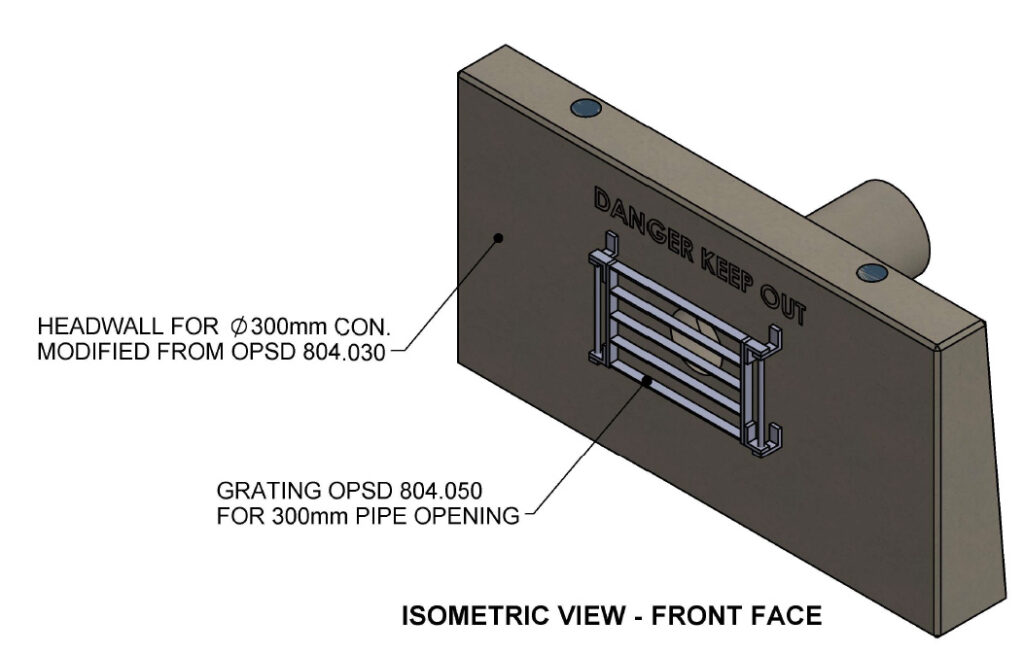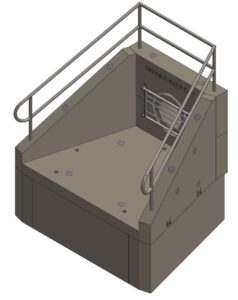
MORE INFORMATION
Headwalls are crucial structural components typically installed at the outlet of a pipe or culvert to facilitate the controlled discharge of water into open watercourses. These structures are designed to serve several important functions, particularly in managing the flow of water and preventing damage to surrounding environments. By ensuring the proper discharge of water, headwalls play a key role in controlling erosion, mitigating scour, and anchoring the pipe or culvert in place to maintain the integrity of the entire drainage system.
Standards and Specifications:
The design and construction of headwalls are governed by specific standards to ensure consistency and quality in their performance. In Ontario, headwalls are typically built in accordance with the Ontario Provincial Standard Drawings (OPSD), particularly:
- OPSD 804.030 and 804.040: These standards define the specifications for the design and construction of headwalls, ensuring that they meet the necessary structural and hydraulic performance requirements. It covers the dimensions, materials, and installation methods for headwalls at the outlet of a pipe or culvert.
- OPSD 804.050: This standard outlines the specifications for grates, which are often used in conjunction with headwalls to cover the outlet or opening. Grates help prevent debris from entering the pipe or culvert while allowing for the controlled flow of water. The standard ensures that grates are properly designed to withstand hydraulic forces and environmental conditions.
Functions and Benefits of Headwalls:
- Erosion and Scour Control: When water exits a culvert or pipe, it can create turbulence that leads to erosion of the surrounding soil or scouring at the outlet, which can cause instability in the surrounding environment. Headwalls help to control and direct the flow of water in a more controlled manner, reducing the velocity and impact at the outlet. By doing so, they help prevent the erosion of soil at the discharge point and reduce the likelihood of scour damage to the culvert or pipe, ensuring long-term functionality.
- Anchoring the Pipe or Culvert: The installation of headwalls also provides structural support for the pipe or culvert. Headwalls anchor the pipe at its outlet, helping to maintain the alignment of the drainage system. This is particularly important for preventing displacement or shifting of the pipe, which can lead to clogs, leaks, or failure of the system. By stabilizing the pipe, headwalls ensure the integrity and efficiency of the entire drainage system.
- Enhanced Hydraulic Efficiency: In addition to structural stability, headwalls help optimize the hydraulic performance of the drainage system. By controlling the water flow and minimizing turbulence, headwalls ensure that water flows smoothly from the pipe into the watercourse, reducing the likelihood of blockages or backups. This efficiency is critical for ensuring that drainage systems perform optimally during periods of heavy rainfall or flooding.
- Environmental Protection: Headwalls contribute to the protection of surrounding landscapes and ecosystems. By directing water flow in a controlled manner, they prevent sediment and pollutants from being swept into nearby watercourses, helping to maintain water quality. Additionally, headwalls can be designed to blend into the natural environment, reducing their visual impact on the landscape.
Concast is committed to providing the highest quality precast headwall products. Additionally, we offer custom design services tailored to your specific requirements. Reach out to us today for more details.

804.030 As shown above.

804.040 As shown above.
